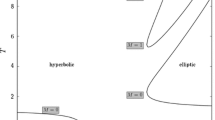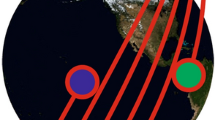Abstract
A procedure is described that provides a universal solution for Lambert's problem. Based on the approach of Lancaster and his colleagues, the procedure uses Halley's cubic iteration process to evaluate the unknown parameter, x, at the heart of the approach, initial estimates for x being selected so that three iterations of the process always suffice to yield an accurate value. The overall procedure has been implemented via three Fortran-77 subroutines, listings of which are appended to the paper, and the way in which the subroutines have been tested is outlined.
Similar content being viewed by others
References
Battin, R. H.: 1987, An Introduction to The Mathematics and Methods of Astrodynamics, AIAA, New York.
Boltz, F. W.: 1984, ‘Second-order p-Iterative Solution of the Lambert/Gauss Problem’, J. Astr. Sci., 32, 475–485.
Gooding, R. H.: 1988a, ‘On the Solution of Lambert's Orbital Boundary-Value Problem’, RAE Technical Report 88027.
Gooding, R. H.: 1988b, ‘On Universal Elements, and Conversion Procedures to and from Position and Velocity’, Celest. Mech., 44, 283–298.
Gooding, R. H. and Odell, A. W.: 1988, ‘The Hyperbolic Kepler Equation (and the Elliptic Equation revisited)’, Celest. Mech., 44, 267–282.
Lancaster, E. R. and Blanchard, R. C.: 1969, ‘A Unified Form of Lambert's Theorem’, NASA Technical Note D-5368.
Lancaster, E. R., Blanchard, R. C. and Devaney, R. A.: 1966, ‘A Note on Lambert's Theorem’, J. Spacecraft Rockets, 3, 1436–1438.
Odell, A. W. and Gooding, R. H.: 1986, ‘Procedures for Solving Kepler's Equation’, Celest. Mech., 38, 307–334.
Sarnecki, A. J.: 1988, “‘Minimal” Orbital Dynamics’, Acta Astronautica, 17, 881–891.
Sun, F. T., Vinh, N. X. and Chern, T. J.: 1987, lsAnalytical Study of the Solution Families of the Extended Godal's Time Equation for Lambert's Problem’, J. Astr. Sci., 35, 213–234.
Taff, L. G. and Randall, P. M. S.: 1985, ‘Two Locations, Two Times and the Element Set’, Celest. Mech., 37, 149–159.
Volk, O.: 1980, ‘Johann Heinrich Lambert and the Determination of Orbits for Planets and Comets’, Celest. Mech., 21, 237–250.
Wintner, A.: 1941, The Analytical Foundations of Celestial Mechanics, Princeton, New Jersey.
Author information
Authors and Affiliations
Rights and permissions
About this article
Cite this article
Gooding, R.H. A procedure for the solution of Lambert's orbital boundary-value problem. Celestial Mech Dyn Astr 48, 145–165 (1990). https://doi.org/10.1007/BF00049511
Revised:
Accepted:
Issue Date:
DOI: https://doi.org/10.1007/BF00049511




